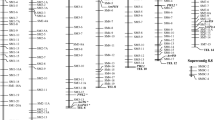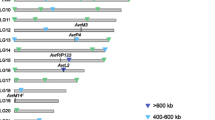Abstract
Magnaporthe oryzae is a model for plant pathogenic filamentous fungi. We have assembled a simple sequence repeat (SSR)-based physical map of the species, using in silico sequence data. A set of 120 SSR markers was developed from the genomic sequence of the reference isolate 70-15. These markers were readily amplified from the genomic DNA of other isolates, and high levels of allelic variation characterised the parental isolates of the two crosses tested. All the markers were locatable to one of the seven M. oryzae chromosomes. An SSR-based physical in silico map was constructed, and pre-existing SSR and RFLP loci were integrated into the map, along with 23 Avr (avirulence) genes and two other genes of importance to the plant/pathogen interaction. This map provides a platform for population genetics and functional genomics studies in the model pathogen, and even in other evolutionally related pathogens.
Similar content being viewed by others
References
Ou S H. Rice Diseases, 2nd ed. Kew Surrey: Commonwealth Mycological Institute, 1985. 109–201
Orbach M J, Chumley F C, Valent B. Electrophoretic karyotypes of Magnaporthe grisea pathogens of diverse grasses. Mol Plant-Microbe Interact, 1996, 9: 261–271
Zhu H, Blackmon B, Sasinowski M, et al. Physical map and organization of chromosome 7 in the rice blast fungus, Magnaporthe grisea. Genome Res, 1999, 9: 739–750
Talbot N J. Having a blast: Exploring the pathogenicity of Magnaporthe grisea. Trends Microbiol, 1995, 3: 9–16
Dean R A, Talbot N J, Ebbole D J, et al. The genome sequence of the rice blast fungus Magnaporthe grisea. Nature, 2005, 434: 980–986
Rho H S, Kang S, Lee Y H. Agrobacterium tumefaciens-mediated transformation of the plant pathogenic fungus, Magnaporthe grisea. Mol Cells, 2001, 12: 407–411
Kaye C, Milazzo J, Rozenfeld S, et al. The development of simple sequence repeat markers for Magnaporthe grisea and their integration into an established genetic linkage map. Fungal Genet Biol, 2003, 40: 207–214
Skinner D Z, Leung H, Leong S A. Genetic map of the blast fungus Magnaporthe grisea. In: O’Brien S J, ed. Genetic Maps. 5th ed. Cold Spring Harbor: Cold Spring Harbor Laboratory, 1990. 382–383
Romao J, Harmer J E. Genetic organization of a repeated DNA sequence family in the rice blast fungus. Proc Natl Acad Sci USA, 1992, 89: 5316–5320
Budde A D, Smith J R, Farman M L, et al. Genetic map of the fungus Magnaporthe grisea. In: O’Brien S J, ed. Genetic Maps. 6th ed. Cold Spring Harbor: Cold Spring Harbor Laboratory, 1993. 3110–3111
Skinner D Z, Budde A D, Farman M L, et al. Genome organization of Magnaporthe grisea: Genetic map, electrophoretic karyotype, and occurrence of repeated DNAs. Theor Appl Genet, 1993, 87: 545–557
Sweigard J A, Valent B, Orbach M J, et al. Genetic map of the rice blast fungus Magnaporthe grisea. In: O’Brien S J, ed. Genetic Maps. 6th ed. Cold Spring Harbor: Cold Spring Harbor Laboratory, 1993. 3112–3117
Farman M L, Leong S A. Genetic and physical mapping of telomeres in the rice blast fungus, Magnaporthe grisea. Genetics, 1995, 140: 479–492
Nitta N, Farman M L, Leong S A. Genome organization of Magnaporthe grisea: Integration of genetic maps, clustering of transposable elements and identification of genome duplications and rearrangements. Theor Appl Genet, 1997, 95: 20–32
Martin S L, Blackmon B P, Rajagopalan R, et al. MagnaportheDB: A federated solution for integrating physical and genetic map data with BAC end derived sequences for the rice blast fungus Magnaporthe grisea. Nucleic Acids Res, 2002, 1: 121–124
Akagi H, Yokozeki Y, Inagaki A, et al. Microsatellite DNA markers for rice chromosomes. Theor Appl Genet, 1996, 93: 1071–1077
Tautz D, Renz M. Simple sequences are ubiquitous repetitive components of eukaryotic genomes. Nucleic Acids Res, 1984, 12: 4127–4138
Weber J L, May P E. Abundant class of human DNA polymorphisms which can be typed using the polymerase chain reaction. Am J Hum Genet, 1989, 44: 388–396
McCouch S R, Teytelman L, Xu Y B, et al. Development and mapping of 2240 new SSR markers for rice (Oryzae sativa L.). DNA Res, 2002, 9: 199–207
Moretzsohn M C, Leoi L, Proite K, et al. A microsatellite-based, gene-rich linkage map for the AA genome of Arachis (Fabaceae). Theor Appl Genet, 2005, 111: 1060–1071
Li C Y, Li J B, Zhou X G, et al. Frequency and distribution of microsatellite in the whole genome of rice blast fungus Magnaporthe grisea. Chin J Rice Sci (in Chinese with English abstract), 2004, 18: 269–273
Brondani C, Brondani R P V, Garridon L R, et al. Development of microsatellite markers for genetic analysis of Magnaporthe grisea. Genet Mol Biol, 2000, 23: 753–762
Kim N S, Armstrong K C, Fedak G, et al. A microsatellite sequence from the rice blast fungus (Magnaporthe grisea) distinguishes between the centromeres of Hordeum vulgare and H. bulbosum in hybrid plants. Genome, 2002, 45: 165–174
Chen X, Chao Y G, McCouch S R. Sequence divergence of rice microsatellites in Oryza and other plant species. Mol Gen Genomics, 2002, 268: 331–343
Ma J H, Wang L, Feng S J, et al. Identification and fine mapping of AvrPi15, a novel avirulence gene of Magnaporthe grisea. Theor Appl Genet, 2006, 113: 875–883
Feng S J, Wang L, Ma J H, Lin F, and Pan Q H. Genetic and physical mapping of AvrPi7, a novel avirulence gene of Magnaporthe oryzae using physical position-ready markers. Chin Sci Bull, 2007, 52: 903–911
Panaud O, Chen X, McCouch S R. Development of microsatellite markers and characterization of simple sequence length polymorphism (SSLP) in rice (Oryza sativa L.). Mol Gen Genomocs, 1996, 252: 597–607
Li C Y, Li J B, Zhou X G, et al. Frequency and distribution of microsatellites in the genome of filamentous fungus, Neurospora crassa. Chinese J Rice Sci (in Chinese with English abstract), 2004, 37: 851–858
Li C Y, Li J B, Zhou X G, et al. Frequency and distribution of variable-number tandem repeats in the genome of Aspergillus niculans. Acta Genet Sin (in Chinese with English abstract), 2005, 32: 538–544
Wu W H, Wang L, Pan Q H. Comparison of genetic structures of two rice blast gungus populations originated from Jiangsu and Yunnan Provinces, China. Chin J Tropical Crops (in Chinese with English abstract), 2006, 17: 95–100
Hayashi N, Li C Y, Li J R, et al. In vitro production on rice plants of perithecia of Magnaporthe grisea from Yunnan, China. Mycol Res, 1997, 101: 1308–1310
Zhu Y Y, Chen H R, Fan J H, et al. Genetic diversity and diseases control in rice. Nature, 2000, 406: 718–722
Cho Y G, Ishii T, Temnykh S, et al. Diversity of microsatellites derived from genomic libraries and GenBank sequences in rice (Oryza sativa L.). Thero Appl Genet, 2000, 100: 713–722
Upupa S M, Robertson L D, Weigand F, et al. Allelic variation at (TTA)n microsatellite loci in a word collection of chickpea (Cicer arietinum L.) germplasm. Mol Gen Genomics, 1999, 261: 354–363
Burstin J, Deniot G, Potier J, Weinachter C, et al. Microsatellite polymorphism in Pisum sativum. Plant Breed, 2001, 120: 311–317
Sweigard J A, Carroll A M, Kang S, et al. Identification, cloning, and characterization of PWL2, a gene for host species specificity in the rice blast fungus. Plant Cell, 1995, 7: 1221–1233
Mandel M A, Crouch V W, Gunawardena U P, et al. Physical mapping of the Magnaporthe grisea AVR1-MARA locus, reveals the virulent allele contains two deletions. Mol Plant-Microbe Interact, 1997, 10: 1102–1105
Farman M L, Leong S A. Chromosome walking to AVR1-CO39 avirulence gene of Magnaporthe grisea discrepancy between the physical and genetic maps. Genetics, 1998, 150: 1049–1058
Dioh W, Tharreau D, Notteghem J L, et al. Mapping of avirulence genes in the rive blast fungus, Magnaporthe grisea, with RFLP and RAPD markers. Mol Plant-Microbe Interact, 2000, 13: 217–227
Orbach M J, Farrall L, Sweigard J A, et al. A telomeric avirulence gene determines efficacy for the rice blast resistance gene Pi-ta. Plant Cell, 2000, 12: 2019–2032
Wang B H, Lu G D, Lin W M, et al. Genetic analysis and molecular marker of Avr-Pi1, Avr-Pi2 and Avr-Pi4a of Magnaporthe grisea. Acta Genet Sin, 2002, 29: 820–826
Wang Y L, Kaye C, Bordat A, et al. Construction of genetic linkage map and location of avirulence genes from cross CH63 and TH16 of Magnaporthe grisea. Chin J Rice Sci (in Chinese with English abstract), 2005, 19: 160–166
Böhnert H U., Fudal I, Dioh W, et al. A putative polyketide synthase/peptide synthetae from Magnaporthe grisea signals pathogen attack to resistance rice. Plant Cell, 2004, 16: 2499–2513
Luo C X, Fujita Y, Yasuda N, et al. Identification of Magnaporthe oryzae avirulence genes to three rice blast resistance genes. Plant Dis, 2004, 88: 265–270
Yasuda N, Noguchi M T, Fijita Y. Identification of an avirulence gene in the fungus Magnaporthe grisea corresponding to a resistance gene at the Pik locus. Phytopathology, 2005, 95: 768–772
Chen Q H, Wang Y C, Zheng X B. Genetic analysis and molecular mapping of the avirulence gene PRE1, a gene for host-species specificity in the rice blast Magnaporthe grisea. Genome, 2006, 49: 873–881
Zhang L H, Yan J Y, Zho W S, et al. Mapping of avirulence gene AVR-Pik m in Magnaporthe grisea. Acta Phytopathol Sin (in Chinese with English abstract), 2006, 6: 116–122
Kang S, Chumley F G, Valent B. Isolation of the mating-type genes of the phytopathogenic fungus Magnaporthe grisea using genomic subtraction. Genetics, 1994, 138: 289–296
Talbot N J, Ebbole D J, Hamer J E. Identification and characterization of MPG1, a gene involved in pathogenicity from the rice blast fungus Magnaporthe grisea. Plant Cell, 1993, 5: 1575–1590
Zhu H, Choi S, Johnston A K, et al. A large insert (130 kbp) bacterial artificial chromosome (BAC) library of the rice blast fungus Magnaporthe grisea: genome analysis, contig assembly and gene cloning. Fungal Genet Biol, 1997, 21: 337–347
Lagercrantz U, Ellegren H, Andersson L. The abundance of various polymorphic microsatellite motifs differs between plants and vertebrates. Nucleic Acids Res, 1993, 21: 1111–1115
Atallah Z K, Larget B, Chen X, et al. High genetic diversity, phenotypic uniformity, and evidence of outcrossing in Sclerotinia sclerotiorum in the Columbia Basin of Washington State. Phytopathology, 2004, 94, 737–742
Ivors K, Garbelotto M, Vries I D, et al. Microsatellite markers identify three lineages of Phytophthora ramorum in US nurseries, yet single lineages in US forest and European nursery populations. Mol Ecol, 2006, 15: 1493–1505
Li Y C, Korol A B, Fahima T et al. Microsatellites within genes: structure, function, and evolution. Mol Biol Evol, 2004, 21: 991–1007
Author information
Authors and Affiliations
Corresponding author
Additional information
These Authors contributed equally to this study
Supported by the National Basic Research Program of China (Grant No. 2006CB100206), Program for Changjiang Scholars and Innovation Research Team in University (Grant No. IRT0448) and the Natural Science Foundation of Guangdong Province (Grant No. 039254; 07300695)
About this article
Cite this article
Feng, S., Ma, J., Lin, F. et al. Construction of an electronic physical map of Magnaporthe oryzae using genomic position-ready SSR markers. Chin. Sci. Bull. 52, 3346–3354 (2007). https://doi.org/10.1007/s11434-007-0498-0
Received:
Accepted:
Issue Date:
DOI: https://doi.org/10.1007/s11434-007-0498-0




